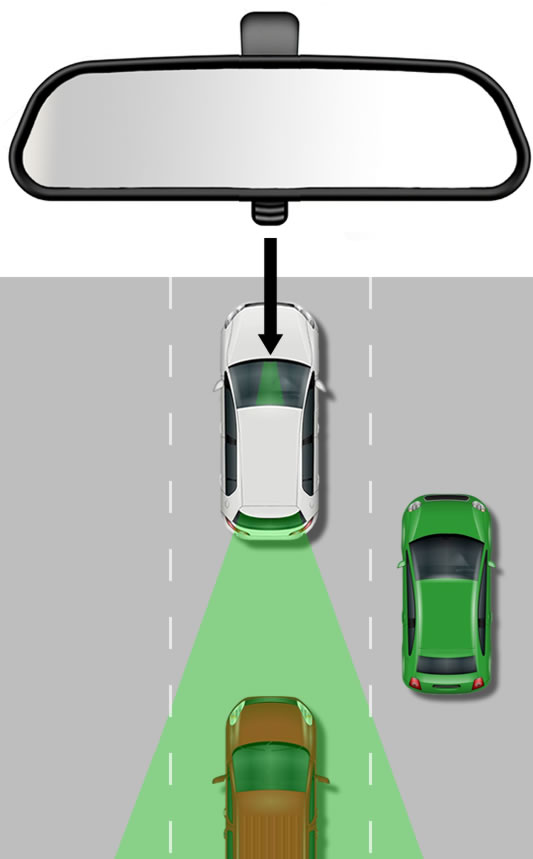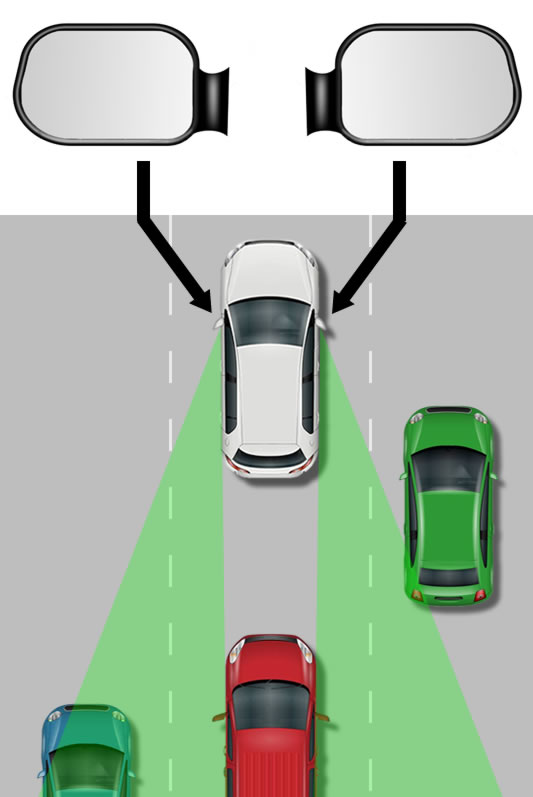There are a total of three mirrors in a typical car. In order to drive safely, it’s important that you make effective use all three mirrors to provide a good level of all-round observation. This tutorial explains what the mirrors in a car are called and with the use of diagrams, we show what field of vision you can see out of them.
Internal Rear View Mirror
The internal rear view mirror, often called the ‘main’ mirror provides the driver with a view of what’s going on behind your car. The glass in the internal mirror is flat, meaning that what you see in the mirror is an exact representation of distance for the vehicles behind.
Always ensure that your internal mirror is set up correctly, to enable you the maximum view to the rear of your car. See adjusting your car mirrors tutorial for instructions.
The internal car mirror is used the most often. You’ll need to look in it (often before a side mirror) before making a change in speed or direction. You also need to look into the internal mirror during general driving, around every 5 to 10 seconds, just to update yourself on what’s going on around your vehicle.

As you can see from the diagram, the internal rear view mirror provides the driver with a limited view of the rear, as illustrated by the green shaded area.
The internal rear view mirror offers very little observation of what’s happening on each side of the car, so for that, you need to look into the side mirrors.
Side Mirrors
There are two side mirrors, one located on each side of the car. They are of course fixed to the doors, hence the alternative name of ‘door’ mirrors, but many years ago they used to be fixed much further ahead, one mirror fixed on each of the car’s wing. If you ever hear the name ‘wing’ mirrors, that’s the reason why.
There’s other names associated with side mirrors including ‘nearside’ mirror meaning the left mirror (passenger side) and the ‘offside’ mirror meaning the mirror on the right (driver’s side). Another name you might hear is ‘external’ mirrors, simply because they’re on the outside of the car.
As with the internal mirror, it’s important to ensure both side mirrors are set up correctly. This will provide the driver with best view to each side of the car. See adjusting your car mirrors tutorial for instructions.

Side mirrors have a different type of glass in them compared to the interior mirror. The type of glass is called ‘convex’, meaning that it’s slightly curved allowing for a wider field of vision.
Side mirrors are often used after the internal rear view mirror just before making a change of direction, for example; making a lane change. As you can see from the diagram, the side mirrors offer a limited view to the side of the car as illustrated by the green shaded area.
There are areas to the side of the car that cannot be seen in the side mirrors and these are called blind spots. Drivers must physically turn their heads to observe these blind spot areas to ensure they are free from vehicles before moving the vehicle into that space.